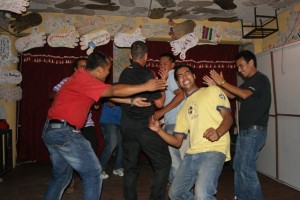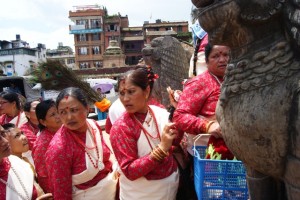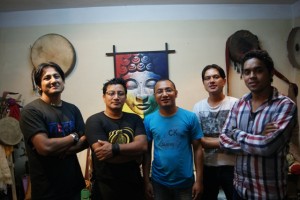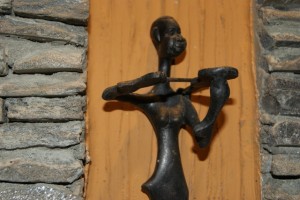“With more than 115 ethnic groups, it is very difficult to collect instruments from every nook and corner of the country,” he says of the practical difficulties. Now, the biggest daunt for Ram Prasad is updating his conservation techniques for which he needs more money. “I have been requesting the government for funds the last 16 years…or since I started the museum. Till now friends have been helping me out but now we have grown too big for a group of individuals to help.” Callous governments, the story is same everywhere. There is always something more urgent, of course.
Preservation takes wings when practised. After looking and asking around on who would be the right guys – the revivalists, those responsible for a new surge of the indigenous, the torch-bearers of heritage, the proud notes of a new Nepal – I zeroed in on the Kutumba band. The band defines themselves as a ‘folk instrumental ensemble’. Their self-professed aim is to bring together traditional and oft-forgotten tunes and musical instruments with new, experimental sounds and tracks that appeal to a wider audience. Hailing from different family backgrounds, bringing with them diverse tastes and talents there is one thing that binds them – the love for music in general and Nepali music in particular. Arun Manandhar, Kiran Nepali, Rubin Kumar Shrestha, Siddharthan Maharjan and Pavit Maharjan started the band which is a household name today. They travel the length and breadth of the country giving shows which play to packed audiences. Everybody loves them as their music has the vibrancy of Nepali culture, the dynamism of the heritage and brims with new hopes that rise from whiffs of melancholy. From tracking the revival of the forgotten music of Nepal, I moved to rejuvenating the rich traditions with richer influences. And reached the house of Ani Choying Drolma. Ani Choying Drolma. The accidental nun. The celebrated chanter. The singer with a cause. Born in 1971 to Tibetans in exile in Nepal, Ani Choying decided to become a nun to escape a physically abusive father. She was accepted to a nunnery at the tender age of 13 and soon began her training under the resident chant master. The head lama, the Rinpoche, recognised her talent and started to train her personally in the sacred chants of Buddhism. Having brought out 10 albums so far, the monies she gets from the sales help her support the dozen and more causes close to her heart. The flagship project of her foundation is The Arya Tara School, a free boarding school for nuns, where modern education goes hand in hand with traditional Buddhist studies. Along with the fruition of her dreams to uplift the Tibetan girl child from the biased clutches of society, Ani Drolma also brought a fresh nativity and an uplifting spirituality to local music.“Singing songs doesn’t have to be necessarily about sadness as there are brighter aspects to life,” she told me. As testimony to her belief, Ani Drolma’s eyes twinkle all the time.
The origins of the rich music tradition of Nepal can be traced back to the times of the powerful kings of the country who were all patrons of music and art. The Mallas were particularly fond of performing arts which were accompanied by music. The Newari brand of music is believed to have flourished during this era. Along with Newari, there are others too which enjoyed a flourishing patronage by the lords of the land. Gurung, Kirant, Deuda and Tamang are the important ones among them. The Dohori, meaning folksong in Nepali, is also seeing a slow revival in recent years.Along with worthy efforts at preservation of a rich musical heritage, there are also defining influences which can only complement the ever-growing tradition that is Nepali music. The music of the hippy days, the 60s, was copycat rock and roll aped from the west. Later on Indian film music wielded the baton with cabaret and disco. Several trials and errors later, there is more or less a unanimity that the future of Nepal lies within Nepal. Precisely the reason why bands like Kutumba are very much in demand today.

















Sir,
Cant tell you what precisely, but something is missing in the column.
Please find it out and add it. I miss your flow.